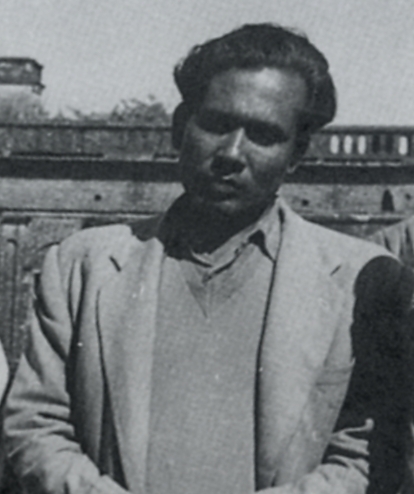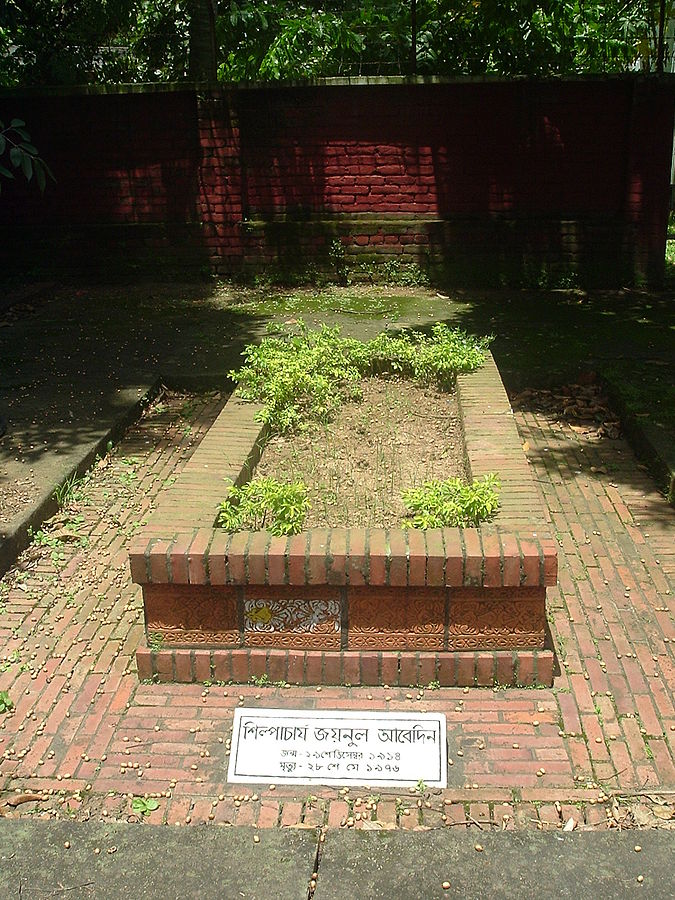Zainul Abedin/জয়নুল আবেদিন
Born December 29, 1914
Kishoreganj, East Bengal, British Raj (now Bangladesh)
Died May 28, 1976 (aged 61)
Nationality Bangladeshi
Known for Painting
Zainul Abedin (Bengali: জয়নুল আবেদিন; December 29, 1914 – May 28, 1976) was a Bengali painter. He got the break through in 1944 with his Famine Series paintings of 1943. After partition he moved to Pakistan; and finally when Bangladesh was created in 1971, he was rightly considered the founding father of Bangladeshi art. He was an artist of exceptional[peacock term] talent and international repute. Like many of his contemporaries, his paintings on the Bengal famine of 1940s is probably his most characteristic work. In Bangladesh, he is referred[by whom?] with honor as Shilpacharya (Great Teacher of the Arts) in Bangladesh for his artistic and visionary qualities.
Early life and education
Zainul Abedin was born in Kishoreganj, East Bengal on December 29, 1914. Much of his childhood was spent near the scenic banks of the Brahmaputra river. Brahmaputra would later appear in many of his paintings and be a source of inspiration all throughout his career. Many of his works framed Brahmaputra and a series of watercolors that Zainul did as his tribute to the Brahmaputra river earned him the Governor's Gold Medal in an all-India exhibition in 1938.This was the first time when he came under spotlight and this award gave Abedin the confidence to create his own visual style.In 1933, Abedin was admitted to Calcutta Government Art School in Calcutta. Here for five years he learned British/ European academic style and later he joined the faculty of the same school after his graduation. He was dissatisfied with the orientalist style and the limitations of European academic style and this led him towards realism. He was the pioneer of the modern art movement that took place in Bangladesh. In 1948 he, and with the help of few of his colleagues, founded an art institute in Dhaka. That time there were no art institute present in Dhaka and he was the founding principal of that institute.
After completing his two years of training from an art school in London, he began a new style, "Bengali style", where folk forms with their geometric shapes, sometimes semi-abstract representation, the use of primary colors were the main features. But in all his drawing one thing was prominent that his lack of idea in perspective. Later he realized the limitations of folk art, so he went back to the nature, rural life and the daily struggles of man to combination of art that would be realistic but modern in appearance.
Famine paintings
Among all the contemporary works of Zainul Abedin, his famine sketches of 1940s are his most remarkable works. He created his famine painting set, which, when exhibited in 1944, brought him even more critical acclaim. The miserable situation of the starving people during the great famine of Bengal in 1943 touched his sensitive heart very deeply. He made his own ink by burning charcoal and using it on cheap ordinary packing paper, he depicted those starving people who were dying by the road side in search of little bit of food. What Zainul did was not just documented the famine, but in his sketches the famine showed its sinister face through the skeletal figures of people fated to die of starvation in a man-made difficulty. Zainul depicted this inhuman story with very human emotions. This drawings became iconic images of human suffering. This sketches helped him find his way in a realistic approach that focused the human suffering, struggle and protest. The Rebel crow marks a high point of that style. This particular brand of realism combines social inquiry and the protest with higher aesthetics.
He was an influential member of the Calcutta Group of progressive artists and was friends with Shahid Suhrawardy and Ahmed Ali of the Progressive Writer's Movement.
Liberation movement
Post-independence era
In 1975, he founded the Folk Art Museum at Sonargaon in Narayanganj, and Zainul Abedin Sangrahashala, a gallery of his own works in Mymensingh. Abedin developed lung cancer and died on May 28, 1976 in Dhaka. Two faces was his last painting, completed shortly before his death.In 1982, 17 of the 70 pictures housed in Zainul Abedin Sangrahashala were stolen. Only 10 were later recovered. His famous painting "Study of a Crow" (Ink Wash) in the collection of Professor Ahmed Ali is listed in the book 'Arts in Pakistan" by Jalaluddin Ahmed, 1952, including an exclusive monologue on him published by FOMMA, Karachi, along with his many Famine Series paintings of 1943.
Honours
In 2009, a crater on the planet Mercury was named Abedin after the painter.For more detail visit here; http://adf.ly/sFbP4
Zainul Abedin art work












0 comments:
Post a Comment